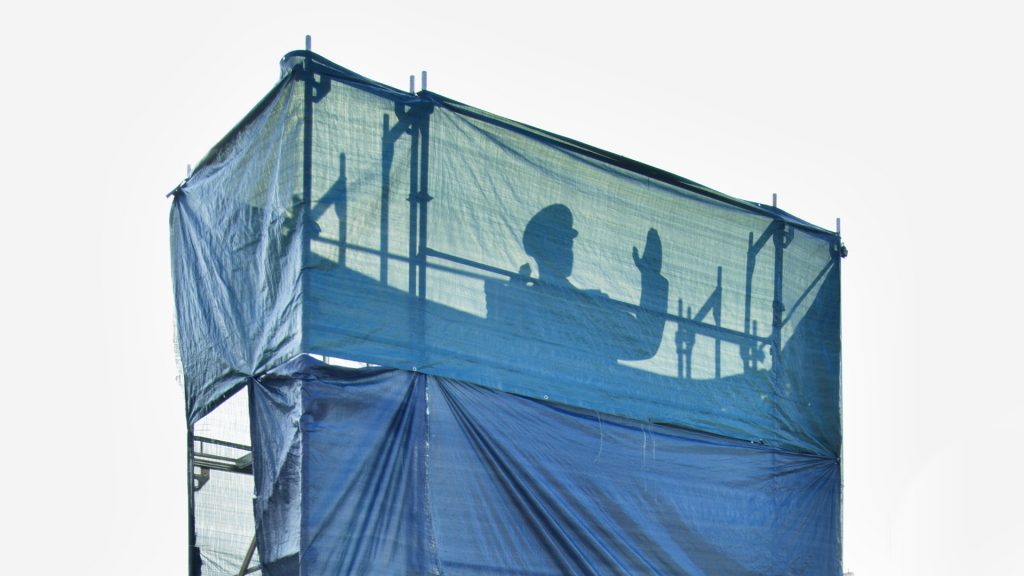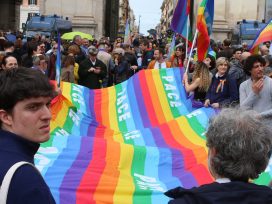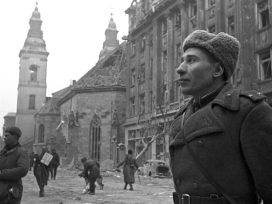Paradise lost?
The removal in April of the monument to Red Army general Ivan Konev in Prague and the rehabilitation of the collaborationist Russian Liberation Army is typical of the revisionist tendency in central eastern European history politics since 1989. Narratives of heroism and victimhood, where the villains were always Nazis or communists, are easily exploited by nationalist extremists.
The Czech Republic has recently seen heated and, at times, hostile debates surrounding the removal of a statue of Red Army general Ivan Konev from Interbrigády Square, in Prague’s affluent Bubeneč district. Meanwhile, the construction of a monument to the Russian Liberation Army (RLA), an anti-Soviet unit that helped liberate Prague in 1945, is imminent.1 This may appear to be no more than an isolated socio-political conundrum, peculiar to a small central European state – but it can also be viewed through the broader lens of World War II historiography and in the context of post-Soviet attitudes in central and eastern Europe, which are overwhelmingly dominated by anti-communism and introspective nationalism.
Clearly, the crimes Konev committed in his military role humiliate and offend the Czech nation, but the crimes of the RLA are now perceived as redeemed by the unit’s tactical turn against Hitler at the end of the war, and by the fact that any criminal acts were not committed against the Czech people. While RLA soldiers, led by Andrey Vlasov, are now depicted as men in a difficult situation, Konev is judged to have been a figure who concealed a callous and inhuman disposition.

Konev Monument in the Bubeneč district of Prague, removed in April 2020. Prague Photo by Gampe from Wikimedia Commons
For the people of central and eastern Europe, the fall of the Eastern Bloc meant long-awaited liberation from an image of the world mediated by communist ideology. But what really happened when homo sovieticus, with his meticulously formed ‘captive mind’, unexpectedly gained freedom after four decades of intellectual confinement? The rediscovery of independence, along with an all-pervading sense of western victory over the East, implied a need to make a clean break with the past. Every nation-state in central and eastern Europe has prioritised the consolidation and strengthening of its position in ‘the West’. Consequently, it has become necessary for each country to shake off its communist legacy and establish a new national history visibly based on western, anti-communist values.
Central and eastern European states have also embarked on a search for their ‘great national story’, the historical narrative which began when they first achieved political independence and sovereignty. In the central European space, emerging nationalism has not led to the calamitous effects observed in former Yugoslavia, yet even nations as culturally close as the Czechs and Slovaks have found it impossible to coexist in a single state.
Just as a slave is likely to retain her mindset and sense of bondage after the slave-owner’s death, so the thinking of homo sovieticus has changed little since the demise of the Soviet Union. The approach to the examination and understanding of the past in east-central Europe has been neither critical nor objective. Instead, all too often, the interpretation of history has simply been inverted, on the assumption that this would clear the way for the revelation of long-suppressed truths.
Initially, the process of distinguishing truth from lies seemed straightforward and simple – which is how the re-writing of 20th century history began. The more ideologically skewed the Soviet interpretation of history seemed to be, the more objective the western perspective on the Cold War appeared. Heroic depictions of the Red Army were replaced by an influx of literature questioning Soviet military capabilities. We came to know that, under Stalin, the largest and the most professional army in history – the Wehrmacht – was destroyed not by the Soviet armed forces but by the Russian winter. We also came to believe that communist partisans, once celebrated for their heroism, were no more than criminals who provoked the Nazis into terror, stole food from civilians and raped their wives.
The massacre of Polish officers in Katyn, and the lethal halt of Red Army operations in an eastern suburb of Warsaw during the city’s 1944 uprising against German occupation, were also key to the formation of the post-Soviet narrative of the Second World War in Poland. Emphasising national heroism and the suffering caused by foreign usurpers – both Nazi and communist – has become the most salient feature of post-war historiography since the 1990s.
It is hardly surprising that the attention of historians has shifted towards topics supressed by communist propaganda after the Soviet order had collapsed. But post-communist historiography has overwritten itself. If ‘history is written by victors’, in this case the victor’s position has been held on the assumption that the loser must forever eat dust and that former Eastern Bloc states must focus primarily on their own national histories – especially on events featuring the loser. Consequently, anyone who fought ‘the Bolsheviks’ instantly became a hero. The new national historiography mirrored the very attitudes and methodologies that had characterised the former regime, and the heroes of post-Soviet history are bathed in the same shining glory as the erstwhile heroes of communist propaganda.
In Ukraine, the late 1980s saw the emergence of a cult of two radical nationalists: Stepan Bandera and Roman Shukhevych. In the Baltic area, Lithuanian historians and journalists have re-discovered anti-communist partisans previously excluded from historical narratives by the communist regime. In Hungary, the regime of Admiral Miklós Horthy is now viewed as authoritarian rather than fascist, while only the extreme right Arrow Cross Party is identified as having collaborated with Hitler. Similarly, the Protectorate of Bohemia and Moravia is not regarded as pro-Third Reich, and it is emphasised that Czech paratroopers assassinated Reinhard Heydrich (thereby causing thousands of innocent civilians to be killed or despatched to concentration camps during Nazi retaliations). The Polish Home Army 2have become knights in shining armour; both historians and laypersons tell idealised stories of how they fought Hitler, Stalin, or Ukrainian nationalists – anyone who threatened the sovereignty of the Polish nation. In national narratives of this ilk, Jozef Tiso’s pro-Nazi Slovak state is offset by accounts of the Slovak National Uprising, when – it is said – the people finally expressed their true stance towards the Reich. As Tony Judt wrote back in 1992:
The mismemory of communism is also contributing, in its turn, to a mismemory of anticommunism. Marshal Antonescu, the wartime Romanian leader … is now being rewritten into Romanian popular history as a hero, his part in the massacre of Jews and others in wartime Romania weighing little in the balance against his anti-Russian credentials. Anticommunist clerics throughout the region, nationalists who fought alongside the Nazis in Estonia, Lithuania, and Hungary, rightwing partisans who indiscriminately murdered Jews, communists and liberals in the vicious score settling of the immediate postwar years before the communists took effective control are all candidates for rehabilitation as men of laudable convictions; their strongest suit, of course, is the obloquy heaped upon them by the former regime.3
When post-Soviet nations began to frame the history of the Second World War in an ideology of anti-communist nationalism, the emerging narrative was deprived of crucial perspectives. The fact that the nation that killed Heydrich had also manufactured the tanks that spread death and terror throughout Europe was forgotten. Elsewhere, the fighters of the Ukrainian Insurgent Army – who defied Stalin after 1945 and are now being exalted as heroes – had previously done a considerable amount of work for the Nazis in local militias and auxiliary police battalions,4 in which they often remained until the German defeat became fully evident. In Ukraine, their participation in the Volhynia massacres and the Holocaust remains shrouded in silence.
Likewise, Lithuanian partisans who resisted Stalin in forested areas were had in many cases, not long before, participated in German ‘hunts’ for Jews struggling to flee the fate which, they knew, awaited them. Meanwhile, the Polish Home Army wore its shining armour only when protecting Polish citizens – where other nationalities were concerned, its members behaved in a far less honourable way. Slovakia, which rose up to ease the advance of the Red Army, had previously provided soldiers for Hitler’s eastern campaign. In fact, a number of Hlinka Guard Emergency Divisions remained loyal to the Third Reich until the end. And Miklós Horthy, who encouraged the Hungarians to lay down arms, personally introduced antisemitic legislation into the country as early as 1920.
In his article ‘Balancing the books’ Timothy Snyder has noted that: ‘No Pole and no Jew, for example, would confuse the Ghetto Uprising of 1943 with the Warsaw Uprising of 1944. This happens routinely in western Europe.’ Regrettably, even today, this also happens routinely in every east-central European country except Poland. Thirty years of shaping an anti-communist history of the national Second World War has had its effects. Today there exists what Judt called a ‘canyon of ignorance between national histories that works against the emergence of any new common understanding of the shared European past’.5
It is an ignorance that leads Czechs to an uncritical celebration of the Russian Liberation Army, or puts Stepan Bandera and the Organisation of Ukrainian Nationalists on a pedestal in Ukraine. Blindly anti-communist attitudes often go hand in hand with ignorance of the histories of other states, never mind of the Jews, who are often excluded from national histories altogether. The attitude that celebrates Andrey Vlasov’s army as an anti-Stalinist icon responsible for liberating Prague from the Nazi yoke wholly ignores WWII history of those soldiers engaged in Vlasov’s RLA divisions – particularly, the role they played in suppressing of the Warsaw uprising and, even more startling, their involvement in auxiliary police battalions. Both are left out of the picture in the Czech historical debate about this issue.6
Germany has been confronted with the greatest challenge of all. It took several decades for the narrative depicting the Wehrmacht as clean and heroic, unsullied by the crimes committed by Himmler’s SS on the Eastern front, to be toppled. A travelling exhibition organized by the Hamburg Institute for Social Research and initiated by historian Hannes Heer confronted the German public with the Wehrmacht’s crimes. The exhibition was the outcome of a long-term research project undertaken by a small group of pioneering German historiographers. They found themselves facing unusually harsh obstacles precisely because they were challenging an appealing and widely-accepted narrative. It should be recalled that despite the ‘Historikerstreit’ in the early 1980, German society still remained convinced that ‘Grandpa was not a Nazi’.7 It took the steady and critical approach of historians such as Christian Streit, Manfred Messerschmidt, Gerd R. Ueberschär, Wolfram Wette, Helmut Krausnick and Heinz-Heinrich Wilhelm to ensure that German historiography arrived at a point where holding an exhibition entitled ‘War of Annihilation: Crimes of the Wehrmacht 1941–44’ was possible.8
As Philipp Ther pointed out in his article ‘The Burden of History and the Trap of Memory’, German historiography also struggles with self-victimization, for example with the issue of the expulsion or forced deportation of Germans at the end of the war and after. However, the emphasis on the victimization of deported Germans also stems from a failure to take account of the war crimes the Third Reich committed on the Polish nation (though not exclusively so) and from an urge to evade historical responsibility. Academic and public debates on German war historiography still contain critical references to a never-ending eating humble pie. Yet, the abundance of elaborate and interconnected historiographical narratives relating to the Second World War, built on a thorough study of sources and secondary literature, provides some guarantee against this account of German history.
In central and eastern Europe, however, the historiography of the Second World War has been built on a narrative of heroes, victims and villains. It offers a simplified, uncritical story-line, where the heroes are usually one’s own, the victims are blameless local populations, and the villains are always Nazis or communists. Such simplified, stereotypical narratives easily fall prey to political radicalism and nationalist extremism.9
East-central European countries have refused to take account of any broader temporal or spatial context, and people have shielded their sense of innocence by emphasising and exploiting the narrative of being inhabitants of ‘the lands in between’. In doing so they have neglected the fact that, as Omer Bartov writes, ‘neither the Wehrmacht nor the Red Army marched into paradise; the seething forces of nationalism, resentment, fear and hatred had grown deep into people’s hearts independently of these outside forces. They are raising their ugly heads again throughout Europe today. One cannot fight against them by painting an idyllic picture of the past but by looking it straight in the eye.’10
The Russian Liberation Army (Russkaya osvoboditelnaya armiya), also known as the Vlasov army, was a collaborationist formation, primarily composed of Russians, which fought under German command during part of World War II (1944-1945). On 28 January 1945, it was officially announced that Russian divisions would no longer form part of the German Army. However, former RLA soldiers continued to fight on the Oder front with Heeresgruppe Weichsel in April 1945. In May 1945, the RLA changed sides came to the help of Czech resistance in the Prague uprising against the German occupation.
In Polish: Armia Krajowa (AK).
Tony Judt, 'The Past Is Another Country: Myth and Memory in Postwar Europe', Daedalus, Vol.121, 4/1992, 103.
German: Schutzmannschaften.
Judt, Tony, Rethinking Post-War Europe, Transit. Europaische Revue, Nr. 15 (Fall 1998).
Vlasov’s Division, called 600th Infantry Division, was established 12/1944 from 29th Russian SS Waffen Grenadier Division and 30th Russian SS Waffen Grenadier Division. These two Waffen SS Divisions were established in summer/autumn 1944 mainly from former auxiliary police men (Belarus and Ukraine). In 30th Waffen SS Division it was namely Schuma Battalions No.: 56, 57, 60, 61, 62, 63, 64 the core of Schuma Brigade Siegling. This Siegling Brigade distinguished itself in so called Nazi-Antipartisan Warfare in 1943-44, where the main goal was killing Jews and civilians. The 29th Waffen SS division consisted of people from Kaminski Brigade and this unit participated on suppressing Warsaw uprising. The commander Bronislav Kaminski was executed on Erich von dem Bach Zelewski’s order for looting. Former activities of this unit lead also to the 'Nazi Antipartisan Warfare' on the eastern front. Sources: Georg Tessin, Verbände und Truppen der deutschen Wehrmacht und Waffen SS im Zweiten Weltkrieg 1939–1945, Volume IV, p. 280-281, 291-292. Christian Gerlach, Kalkulierte Morde. Die deutsche Wirtschafts- und Vernichtungspolitik in Weissrussland 1941 bis 1944, Hamburg 1999, p. 944-946. Wolfgang Curilla, Die deutsche Ordnungspolizei und der Holocaust im Baltikum und in Weissrussland, Munich 2006, p. 405-407. Babette Quinkert, Propaganda und Terror in Weißrussland 1941–1944 die deutsche geistige Kriegführung gegen Zivilbevölkerung und Partisanen, Paderborn 2009, p. 311-312. Leonid Rein, The Kings and the Pawns. Collaboration in Byelorussia During World War II, New York – Oxford 2011, p. 367-368.Martin Dean, Collaboration in the Holocaust. Crimes of the Local Police in Belorussia and Ukraine, 1941–1944, Washington 2000, p. 132.
Harald Welzer – Sabine Moller – Karoline Tschuggnall, 'Opa war kein Nazi. Nationalsozialismus und Holocaust im Familiengedächtnis', Frankfurt a/M 2002.
A 1995–99 controversial art exhibition entitled ‘Vernichtungskrieg. Verbrechen der Wehrmacht 1941 bis 1944’ (War of Annihilation: Crimes of the Wehrmacht 1941–44) triggered a massive reappraisal of the role of the Wehrmacht in World War II. The exhibition toured 33 cities in Germany and Austria.
See e.g. Krisztián Ungváry, 'Lager und Fahne sind eins' Fatale Traditionen in Ungarns Erinnerungskultur, Osteuropa Vol. 61, 12/2011, p. 281-301; Wilfried Jilge, Nationalukrainischer Befreiungskampf: Die Umwertung des Zweiten Weltkrieges in der Ukraine, Osteuropa, Vol. 58, 6/2008, p. 167-186; Per Anders Rudling, ‘The Return of the Ukrainian Far Right: the Case of VO Svoboda’, in: Ruth Wodak, John E. Richardson (eds.), 'Analysing Fascist Discourse. European Fascism in Talk and Text', London 2012, p. 228-255. See also Guido Hausmann, Tanja Penter, Der Gebrauch der Geschichte: Ukraine 2014: Ideologie vs. Historiographie, Osteuropa, Vol. 64, 9-10/2014, p. 34-50.
Omer Bartov, ‘Truth and Nothing But: The Holocaust Gallery of the Warsaw POLIN Museum in Context’, in Antony Polonsky, Hanna Węgrzynek and Andrzej Żbikowski, New Directions in the History of the Jews in the Polish Lands, Academic Studies Press, Brighton, 2018, 118
Published 17 August 2020
Original in English
First published by Eurozine
Contributed by Institute for Human Science (IWM) © Vlasta Kordová / Institute for Human Science (IWM) / Eurozine
PDF/PRINTIn collaboration with
Newsletter
Subscribe to know what’s worth thinking about.
Related Articles

The sharp drop in support for Ukraine in Italy has less to do with the traditionally Russia-friendly economic policy of the Italian right, and more with the anti-Americanism rooted in the political culture of the Italian left, which now articulates itself as pacifism.

Russian art museums and galleries, navigating Putin’s censorship, either conform or risk closure. Dissenting cultural workers are sacked, artists arrested. Pro-war propaganda is both sardonically replacing exhibitions once celebrating Soviet Ukraine in Russia and eradicating Ukrainian culture in the occupied territories.





